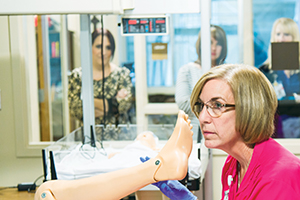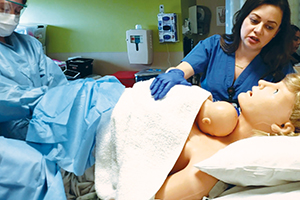By KEN LEISER
The United States is one of the most dangerous places in the developed world to deliver a baby. More than 700 women die each year in the U.S. because of pregnancy-related complications, according to the Centers for Disease Control and Prevention. Across the country, about 50,000 women annually suffer serious complications related to childbirth.
"That's just a travesty," said Cris Daskevich, chief executive at The Children's Hospital of San Antonio and senior vice president of maternal services for the CHRISTUS Health System. "Two women die in childbirth almost every day in our country."

Daskevich
Based out of Irving, Texas, with U.S. hospitals in Texas, Louisiana and New Mexico, CHRISTUS Health is among a growing number of U.S. health systems taking steps to make childbirth safer for mothers and babies. Its initiatives include standardizing maternal health care across all of the system's rural and urban facilities, intensifying efforts to train doctors, nurses and other child-delivery personnel, and sharing best practices with other providers.
Efforts have been underway for several years in the system's home state of Texas, where lawmakers established a Maternal Mortality and Morbidity Task Force. The panel is comprised of maternal-fetal medicine specialists, obstetricians, administrators and nurses. The group began reviewing cases of maternal deaths in May 2015.
In its most recent report, issued in September, the Texas task force reviewed 89 maternal deaths from 2012 and found that 38 percent were pregnancy-related — meaning death of a woman "from any cause related to or aggravated by her pregnancy or its management."

In the CHRISTUS Santa Rosa Simulation Center, Theresa Mangold, clinical director of CHRISTUS Santa Rosa Hospital – Westover Hills, uses a medical manikin to demonstrate techniques used to train doctors and nurses to handle both normal and complex deliveries. The simulation center is located inside The Children's Hospital of San Antonio.
In the deaths that were related to pregnancy, the leading underlying causes were cardiovascular conditions, obstetric hemorrhage, and infection, according to the report. The findings largely mirror national studies looking at the causes of maternal death and injury.
More recently, following a series of articles on maternal mortality and morbidities in USA Today, congressional leaders from both parties sent letters to health agencies within the Donald Trump administration to request briefings on efforts to curb childbirth complications. In May, the CDC released a report showing that three of five pregnancy-related deaths are preventable.
Focus on training
CHRISTUS Health has 27 acute care facilities in the U.S. with 17 that provide obstetric services. Each year, the system delivers about 19,000 babies. CHRISTUS Health's goal is to ensure that every baby is born as healthy as possible and that moms can go home with their babies, said Rhonda Thompson, chief nursing officer at The Children's Hospital of San Antonio and co-chair of CHRISTUS Health's perinatal task force. "The saddest thing for any OB provider is sending a dad home with the baby without mom," Thompson said.
In addition to its participation in the Texas Maternal Mortality and Morbidity Task Force and the TexasAIM quality collaborative, the health system is undertaking several additional measures to improve maternal health, including:
- Creation of a CHRISTUS Health perinatal task force to address maternal-fetal complications and improve processes across the health system as part of a joint effort to elevate women's services in all of its ministries.
- Collaboration among CHRISTUS Health, The Children's Hospital of San Antonio and Baylor College of Medicine to reduce the rising maternal morbidity rate resulting from maternal cardiac arrest. The effort, funded through a $2 million National Institutes of Health grant, will develop curriculum for a national pregnancy resuscitation program to train hospital health care providers and emergency responders who treat pregnant women experiencing cardiac arrest.
- Education and simulation training in obstetric emergencies for nurses and providers to help them identify high-risk patients and intervene early when complications occur.

Deering
Simulating complex births
Dr. Shad Deering, a maternal fetal medicine doctor and CHRISTUS Health's new medical director of simulation, said the childbirth complication of shoulder dystocia — in which the infant's shoulder gets stuck behind the maternal symphysis during delivery — is just one example of how training through simulated childbirths can improve health outcomes.
In the case of shoulder dystocia, a doctor has only four to five minutes to deliver the baby because the umbilical cord is usually compressed, and the baby is not getting oxygen. Historically, the injury rate to the infant has been as high as 40 percent. But a recent study in the United Kingdom found that training providers for the emergency on manikins can significantly reduce the risk of injury, Deering said.

Sandra Martinez, right, a labor and delivery nurse at Providence Holy Cross Medical Center in Mission Hills, Calif., assists Julie Masson, left, during an obstetrics training using a computerized medical manikin. Masson is a nurse leader of the simulation program.
"The better paradigm is how do we practice this and get good at it so when a life's on the line, it isn't like this is the first time the doctor has actually done it," Deering said. Other major maternal events that CHRISTUS will offer simulation training on in the future include maternal cardiac arrest, umbilical cord prolapse and obstetric hemorrhage.
CHRISTUS has simulators at hospitals throughout its system.
Safety protocols
Mercy Medical Center in Baltimore has held down childbirth complications largely because of safety practices that have been in place for years, including a massive transfusion protocol instituted in the obstetrics department 14 years ago to respond to instances of obstetric hemorrhage, said Dr. Robert Atlas, the medical center's chair of obstetrics and gynecology.

Atlas
In addition, Mercy requires the two OB-GYN physician groups that deliver babies at the hospital to have a physician on call virtually around-the-clock, Atlas said. This has helped the hospital "greatly" in its response to emergency situations.
"We have had that in place for probably six years or so," Atlas said. "What we found is that our doctors help each other. You know, if there's a difficult situation, we have someone else who can quickly jump in and help. Our two groups are incredibly collegial with each other, which is awesome."
'Fourth trimester'
Recently, there has been increasing emphasis on the months following childbirth. In April 2018, the American College of Obstetricians and Gynecologists proposed a new paradigm for postpartum care to emphasize the need for ongoing care above and beyond a routine follow-up medical appointment for the mother six weeks after delivery.
"New mothers need ongoing care during the 'fourth trimester,'" said Dr. Alison Stuebe, lead author of the opinion. "We want to replace the one-off checkup at six weeks with a period of sustained, holistic support for growing families."
About 40 percent of women who have given birth do not attend a postpartum visit, the organization said. (Attendance rates are even lower among women with limited resources, contributing to health disparities.) Postpartum visits should include a full assessment of physical, social and psychological well-being.
A study published in the 2016 edition of Obstetrics & Gynecology reviewed 211 maternal deaths in Colorado between 2004 and 2012 and found that "self-harm" — suicide and accidental overdose — was the most common cause of pregnancy-associated mortality, with most of the deaths occurring in the postpartum period. The study, which looked at death certificates, coroner reports and medical records, found 63 — or 30 percent — of the deaths were due to self-harm. The Colorado panel that reviewed maternal deaths did not limit itself to the CDC definition of pregnancy-related mortality, the study stated, which excludes deaths from accidental or incidental causes.

Legrew
Authors of the study also found that while there have been advances in screening and treating mental health disorders during pregnancy, "there has been relatively little focus on maternal deaths resulting from self-harm, specifically those related to accidental overdose and suicide."
Dr. David Legrew is executive medical director of women's services for Providence St. Joseph Health, Southern California, and a high-risk obstetrics specialist.
"The risk for suicide and overdose is actually less while you're pregnant because most women say, 'Wait a second, I don't want to hurt the baby too,'" Legrew said. "But because of postpartum depression, the pressure of a new child, etcetera, then what you see is — paradoxically — an increase in that first year after delivery."
He said that medical professionals need to do a better job in identifying the mothers at higher risk of suicide or overdose "so that we can help them for a longer time period."